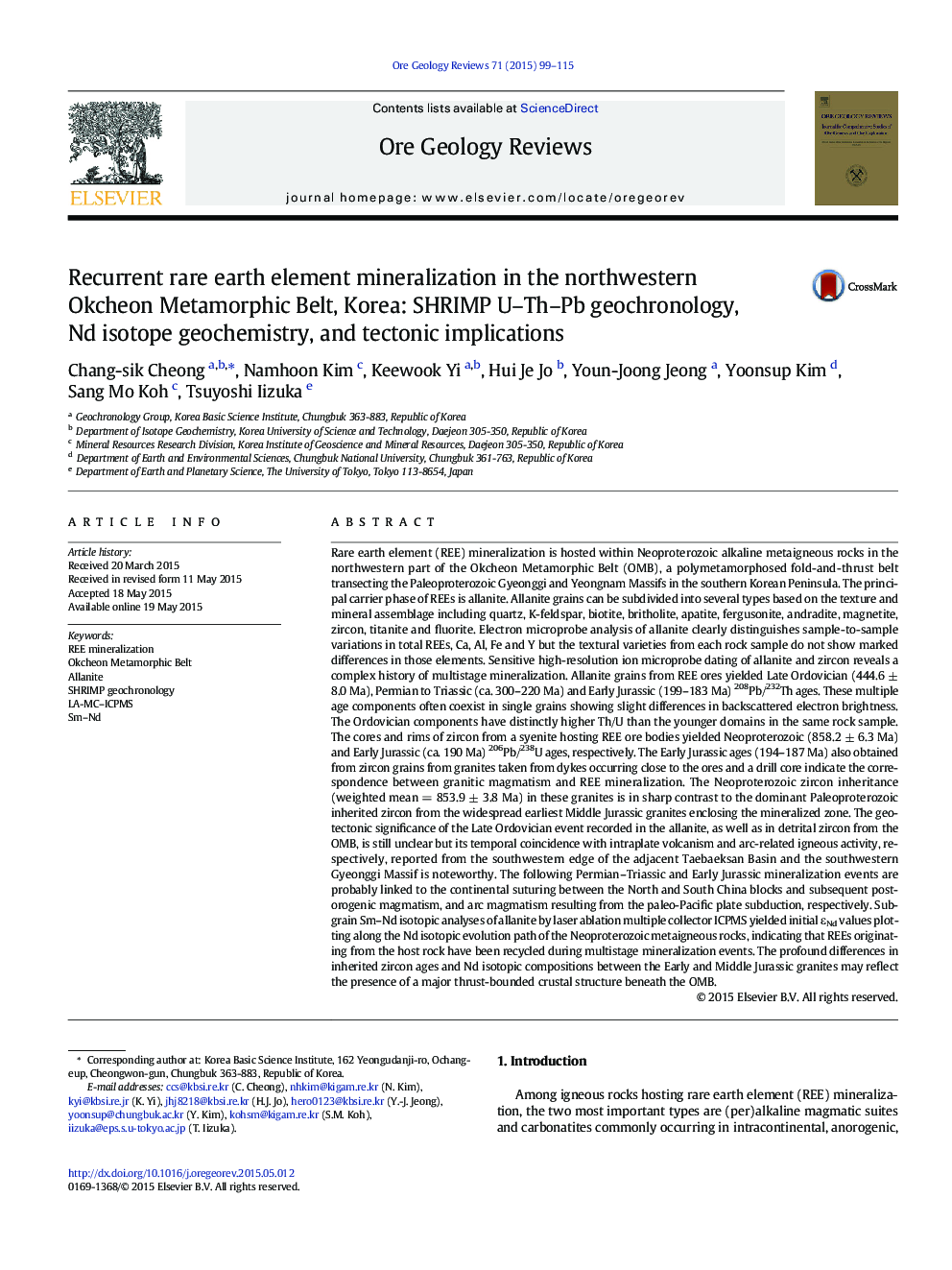| کد مقاله | کد نشریه | سال انتشار | مقاله انگلیسی | نسخه تمام متن |
|---|---|---|---|---|
| 4697011 | 1637233 | 2015 | 17 صفحه PDF | دانلود رایگان |

• REE mineralization is hosted by Neoproterozoic metaigneous rocks in NW OMB, Korea.
• SHRIMP allanite and zircon dating reveals recurrent REE mineralization.
• Each mineralization stage is probably linked to a specific tectonothermal event.
• Sm–Nd isotope data indicate that REEs originating from the host rock have been recycled.
Rare earth element (REE) mineralization is hosted within Neoproterozoic alkaline metaigneous rocks in the northwestern part of the Okcheon Metamorphic Belt (OMB), a polymetamorphosed fold-and-thrust belt transecting the Paleoproterozoic Gyeonggi and Yeongnam Massifs in the southern Korean Peninsula. The principal carrier phase of REEs is allanite. Allanite grains can be subdivided into several types based on the texture and mineral assemblage including quartz, K-feldspar, biotite, britholite, apatite, fergusonite, andradite, magnetite, zircon, titanite and fluorite. Electron microprobe analysis of allanite clearly distinguishes sample-to-sample variations in total REEs, Ca, Al, Fe and Y but the textural varieties from each rock sample do not show marked differences in those elements. Sensitive high-resolution ion microprobe dating of allanite and zircon reveals a complex history of multistage mineralization. Allanite grains from REE ores yielded Late Ordovician (444.6 ± 8.0 Ma), Permian to Triassic (ca. 300–220 Ma) and Early Jurassic (199–183 Ma) 208Pb/232Th ages. These multiple age components often coexist in single grains showing slight differences in backscattered electron brightness. The Ordovician components have distinctly higher Th/U than the younger domains in the same rock sample. The cores and rims of zircon from a syenite hosting REE ore bodies yielded Neoproterozoic (858.2 ± 6.3 Ma) and Early Jurassic (ca. 190 Ma) 206Pb/238U ages, respectively. The Early Jurassic ages (194–187 Ma) also obtained from zircon grains from granites taken from dykes occurring close to the ores and a drill core indicate the correspondence between granitic magmatism and REE mineralization. The Neoproterozoic zircon inheritance (weighted mean = 853.9 ± 3.8 Ma) in these granites is in sharp contrast to the dominant Paleoproterozoic inherited zircon from the widespread earliest Middle Jurassic granites enclosing the mineralized zone. The geotectonic significance of the Late Ordovician event recorded in the allanite, as well as in detrital zircon from the OMB, is still unclear but its temporal coincidence with intraplate volcanism and arc-related igneous activity, respectively, reported from the southwestern edge of the adjacent Taebaeksan Basin and the southwestern Gyeonggi Massif is noteworthy. The following Permian–Triassic and Early Jurassic mineralization events are probably linked to the continental suturing between the North and South China blocks and subsequent post-orogenic magmatism, and arc magmatism resulting from the paleo-Pacific plate subduction, respectively. Sub-grain Sm–Nd isotopic analyses of allanite by laser ablation multiple collector ICPMS yielded initial εNd values plotting along the Nd isotopic evolution path of the Neoproterozoic metaigneous rocks, indicating that REEs originating from the host rock have been recycled during multistage mineralization events. The profound differences in inherited zircon ages and Nd isotopic compositions between the Early and Middle Jurassic granites may reflect the presence of a major thrust-bounded crustal structure beneath the OMB.
Journal: Ore Geology Reviews - Volume 71, December 2015, Pages 99–115